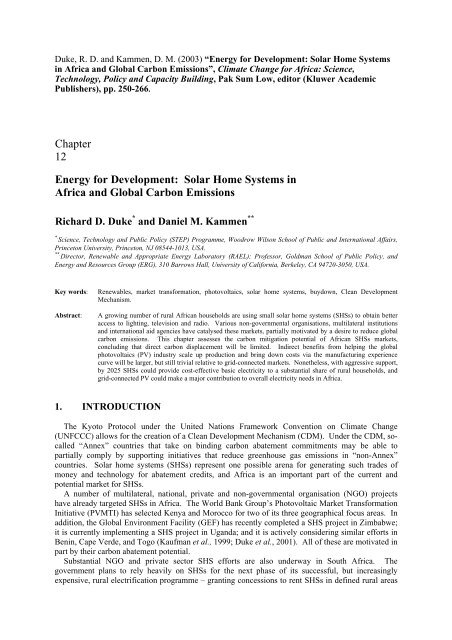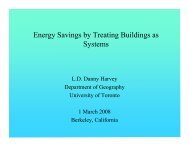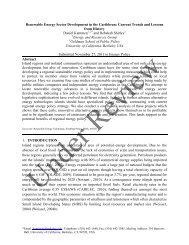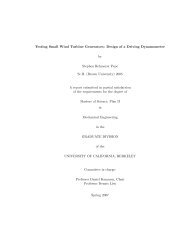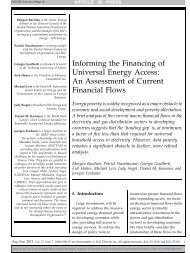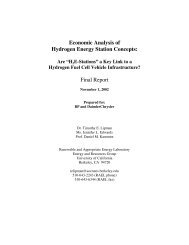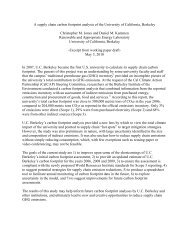Chapter 12 Energy for Development: Solar Home Systems in Africa ...
Chapter 12 Energy for Development: Solar Home Systems in Africa ...
Chapter 12 Energy for Development: Solar Home Systems in Africa ...
- No tags were found...
Create successful ePaper yourself
Turn your PDF publications into a flip-book with our unique Google optimized e-Paper software.
Duke, R. D. and Kammen, D. M. (2003) “<strong>Energy</strong> <strong>for</strong> <strong>Development</strong>: <strong>Solar</strong> <strong>Home</strong> <strong>Systems</strong><strong>in</strong> <strong>Africa</strong> and Global Carbon Emissions”, Climate Change <strong>for</strong> <strong>Africa</strong>: Science,Technology, Policy and Capacity Build<strong>in</strong>g, Pak Sum Low, editor (Kluwer AcademicPublishers), pp. 250-266.<strong>Chapter</strong><strong>12</strong><strong>Energy</strong> <strong>for</strong> <strong>Development</strong>: <strong>Solar</strong> <strong>Home</strong> <strong>Systems</strong> <strong>in</strong><strong>Africa</strong> and Global Carbon EmissionsRichard D. Duke * and Daniel M. Kammen ***. Science, Technology and Public Policy (STEP) Programme, Woodrow Wilson School of Public and International Affairs,Pr<strong>in</strong>ceton University, Pr<strong>in</strong>ceton, NJ 08544-1013, USA.**. Director, Renewable and Appropriate <strong>Energy</strong> Laboratory (RAEL); Professor, Goldman School of Public Policy, and<strong>Energy</strong> and Resources Group (ERG), 310 Barrows Hall, University of Cali<strong>for</strong>nia, Berkeley, CA 94720-3050, USA.Key words:Abstract:Renewables, market trans<strong>for</strong>mation, photovoltaics, solar home systems, buydown, Clean <strong>Development</strong>Mechanism.A grow<strong>in</strong>g number of rural <strong>Africa</strong>n households are us<strong>in</strong>g small solar home systems (SHSs) to obta<strong>in</strong> betteraccess to light<strong>in</strong>g, television and radio. Various non-governmental organisations, multilateral <strong>in</strong>stitutionsand <strong>in</strong>ternational aid agencies have catalysed these markets, partially motivated by a desire to reduce globalcarbon emissions. This chapter assesses the carbon mitigation potential of <strong>Africa</strong>n SHSs markets,conclud<strong>in</strong>g that direct carbon displacement will be limited. Indirect benefits from help<strong>in</strong>g the globalphotovoltaics (PV) <strong>in</strong>dustry scale up production and br<strong>in</strong>g down costs via the manufactur<strong>in</strong>g experiencecurve will be larger, but still trivial relative to grid-connected markets. Nonetheless, with aggressive support,by 2025 SHSs could provide cost-effective basic electricity to a substantial share of rural households, andgrid-connected PV could make a major contribution to overall electricity needs <strong>in</strong> <strong>Africa</strong>.1. INTRODUCTIONThe Kyoto Protocol under the United Nations Framework Convention on Climate Change(UNFCCC) allows <strong>for</strong> the creation of a Clean <strong>Development</strong> Mechanism (CDM). Under the CDM, socalled“Annex” countries that take on b<strong>in</strong>d<strong>in</strong>g carbon abatement commitments may be able topartially comply by support<strong>in</strong>g <strong>in</strong>itiatives that reduce greenhouse gas emissions <strong>in</strong> “non-Annex”countries. <strong>Solar</strong> home systems (SHSs) represent one possible arena <strong>for</strong> generat<strong>in</strong>g such trades ofmoney and technology <strong>for</strong> abatement credits, and <strong>Africa</strong> is an important part of the current andpotential market <strong>for</strong> SHSs.A number of multilateral, national, private and non-governmental organisation (NGO) projectshave already targeted SHSs <strong>in</strong> <strong>Africa</strong>. The World Bank Group’s Photovoltaic Market Trans<strong>for</strong>mationInitiative (PVMTI) has selected Kenya and Morocco <strong>for</strong> two of its three geographical focus areas. Inaddition, the Global Environment Facility (GEF) has recently completed a SHS project <strong>in</strong> Zimbabwe;it is currently implement<strong>in</strong>g a SHS project <strong>in</strong> Uganda; and it is actively consider<strong>in</strong>g similar ef<strong>for</strong>ts <strong>in</strong>Ben<strong>in</strong>, Cape Verde, and Togo (Kaufman et al., 1999; Duke et al., 2001). All of these are motivated <strong>in</strong>part by their carbon abatement potential.Substantial NGO and private sector SHS ef<strong>for</strong>ts are also underway <strong>in</strong> South <strong>Africa</strong>. Thegovernment plans to rely heavily on SHSs <strong>for</strong> the next phase of its successful, but <strong>in</strong>creas<strong>in</strong>glyexpensive, rural electrification programme – grant<strong>in</strong>g concessions to rent SHSs <strong>in</strong> def<strong>in</strong>ed rural areas
Richard D. Duke and Daniel M. Kammento various bus<strong>in</strong>esses, <strong>in</strong>clud<strong>in</strong>g the South <strong>Africa</strong>n utility ESKOM, Shell <strong>Solar</strong>, and the Dutch utilityNuon (Kammen, 1999; Anderson and Duke, 2001).Even complete saturation of the global SHSs market would have a negligible direct impact onglobal carbon emissions. Nonetheless, the CDM, or any similar mechanism that ultimately emerges,might provide an important boost to SHSs markets. As detailed below, carbon abatement creditsgenerated by SHSs could significantly reduce the price of solar electricity <strong>for</strong> rural households <strong>in</strong>develop<strong>in</strong>g countries.In addition to direct abatement (primarily through displacement of kerosene light<strong>in</strong>g, batterycharg<strong>in</strong>g, and to a lesser extent, generators), SHSs may also yield <strong>in</strong>direct carbon emissionsreductions. First, SHSs are a near-term niche market <strong>for</strong> photovoltaics (PV). As such, SHS sales helpto drive the virtuous cycle between (i) cost reductions from greater PV production experience; and (ii)<strong>in</strong>creased global demand <strong>for</strong> PV due to those cost reductions (Duke and Kammen, 1999a). As a resultof these dynamic effects, the <strong>Africa</strong>n SHS market itself may marg<strong>in</strong>ally contribute to ef<strong>for</strong>ts to reducethe global price of PV – though major programmes to subsidise grid-connected residential andcommercial markets <strong>in</strong> Japan, Germany, and other <strong>in</strong>dustrialised countries <strong>in</strong>creas<strong>in</strong>gly dom<strong>in</strong>ateglobal PV markets (Duke, 2002).Another <strong>in</strong>direct carbon benefit associated with SHSs is that they may delay or displaceconventional grid extension. There is no sure-fire technique <strong>for</strong> estimat<strong>in</strong>g the magnitude of thiseffect, but it appears to be operative <strong>in</strong> the South <strong>Africa</strong>n context (Anderson and Duke, 2001).These <strong>in</strong>direct market trans<strong>for</strong>mation and grid displacement benefits are unlikely to be sufficientlyquantifiable to generate certified CDM credits, but they may motivate SHSs <strong>in</strong>vestments and supportfrom public and private funders <strong>in</strong>terested <strong>in</strong> promot<strong>in</strong>g carbon abatement.2. LEARNING AND EXPERIENCE CURVESLearn<strong>in</strong>g curves describe the relationship between cumulative production of a manufactured good,such as PV, and the labour <strong>in</strong>puts necessary per unit produced. 1 Dur<strong>in</strong>g the 1970s, Boston Consult<strong>in</strong>gGroup (BCG) generalised the labour productivity learn<strong>in</strong>g curve to <strong>in</strong>clude all costs necessary toresearch, develop, produce and market a given product (Boston Consult<strong>in</strong>g Group, 1972). That is,BCG argued that learn<strong>in</strong>g-by-do<strong>in</strong>g occurs not only <strong>in</strong> the narrow sense of labour productivityimprovements, but also <strong>in</strong> associated R&D, overhead, advertis<strong>in</strong>g and sales expenses.These efficiency ga<strong>in</strong>s, <strong>in</strong> conjunction with the benefits from scale economies, often yield costreductions characterised by an experience curve:UC = a •q −bWhere UC = unit cost, q = cumulative production, a = the cost of the first unit produced, and b = theexperience parameter. 2 The underly<strong>in</strong>g <strong>in</strong>tuition <strong>for</strong> this exponential relationship is that there aredim<strong>in</strong>ish<strong>in</strong>g returns to experience. Cost reductions are fast <strong>in</strong>itially, but taper off as workerproductivity becomes optimised, production is fully scaled up, <strong>in</strong>cremental process improvements aremade, and so on.Table 1. A taxonomy of learn<strong>in</strong>g-by-do<strong>in</strong>g terms.Labor Costs Only All CostsNo spillover Firm-specific learn<strong>in</strong>g curve Firm-specific experience curvePerfect spillover Industry learn<strong>in</strong>g curve Industry experience curve1 This section draws from Duke and Kammen (1999a).2 See Hirschman (1964), Argote and Epple (1990), and Badiru (1992) <strong>for</strong> variants of the equation. Also, Arrow (1962) uses cumulativecapital goods <strong>in</strong>vestment as the learn<strong>in</strong>g proxy.
<strong>Energy</strong> <strong>for</strong> <strong>Development</strong>: <strong>Solar</strong> <strong>Home</strong> <strong>Systems</strong> <strong>in</strong> <strong>Africa</strong> and Global Carbon EmissionsIn addition to dist<strong>in</strong>guish<strong>in</strong>g between learn<strong>in</strong>g and experience curves, it is also possible to applythis concept to <strong>in</strong>dividual firms or to an entire <strong>in</strong>dustry. Table 1 illustrates the four differentpossibilities. If a given firm is able to completely reta<strong>in</strong> the knowledge that it generates from its ownproduction experience, then a firm-specific learn<strong>in</strong>g or experience curve approach is appropriate.However, to the extent that learn<strong>in</strong>g-by-do<strong>in</strong>g spills over among firms, an <strong>in</strong>dustry-wide approach ismore applicable.Spillovers are often substantial s<strong>in</strong>ce firms rout<strong>in</strong>ely poach employees from each other, purchaseequipment and other <strong>in</strong>puts from the same specialised suppliers, reverse-eng<strong>in</strong>eer their competitors’new products and even resort to <strong>in</strong>dustrial espionage. Lieberman (1987) discusses empirical evidenceof spillovers as high as 60-90% <strong>in</strong> some cases and summarises other empirical literature suggest<strong>in</strong>ghigh spillover rates.Figure 1. Industry-wide experience curve relationships <strong>for</strong> PV (right scale), w<strong>in</strong>d generators (left scale), and gas turb<strong>in</strong>es(left scale). (Source: IIASA/WEC, 1995).The conventional measure of experience is the progress ratio (Dutton and Thomas 1984; Argoteand Epple 1990). For each doubl<strong>in</strong>g of cumulative production, the cost per unit decreases by (1-PR)percent. (what is this PR?) Thus, counter-<strong>in</strong>tuitively, higher progress ratios imply slower costreductions.Figure 1 illustrates experience curves <strong>for</strong> gas turb<strong>in</strong>es, w<strong>in</strong>dmills and PV. The graph shows a tightrelationship between cumulative <strong>in</strong>dustry-wide production and unit price, <strong>in</strong>dicat<strong>in</strong>g that the <strong>in</strong>dustryexperience curve is an appropriate approximation <strong>for</strong> PV. It is, however, important to highlight threeconcerns with this approach.First, the experience curve <strong>for</strong> gas turb<strong>in</strong>es is clearly “k<strong>in</strong>ked” after 1963, underscor<strong>in</strong>g that theslope of experience curves can change abruptly (<strong>in</strong> this case due to a transition from an active researchand <strong>in</strong>novation phase to one dom<strong>in</strong>ated by deployment only). To account <strong>for</strong> this, we employ a rangeof progress ratio estimates <strong>in</strong> this analysis.Second, unit price is an imperfect substitute <strong>for</strong> unit costs. Profit marg<strong>in</strong>s can and do vary, and thiscan be one reason <strong>for</strong> anomalies such as that observed <strong>for</strong> gas turb<strong>in</strong>es (Boston Consult<strong>in</strong>g Group,1972). It is preferable to def<strong>in</strong>e learn<strong>in</strong>g and experience curves us<strong>in</strong>g manufactur<strong>in</strong>g cost; however,where these data are unavailable, price provides a legitimate proxy if any of the follow<strong>in</strong>g conditionshold (Lieberman, 1984):1. Price/cost marg<strong>in</strong>s rema<strong>in</strong> constant over time.2. Price/cost marg<strong>in</strong>s change, but <strong>in</strong> a manner controlled <strong>for</strong> <strong>in</strong> the analysis.3. Changes <strong>in</strong> marg<strong>in</strong>s are small relative to changes <strong>in</strong> production costs.The third condition holds <strong>for</strong> PV s<strong>in</strong>ce real module prices have fallen by a factor of 16 s<strong>in</strong>ce 1975(Johnson, 2002). Thus, short-term changes <strong>in</strong> the price/cost marg<strong>in</strong> <strong>in</strong>troduce only small deviationsrelative to the pronounced long-term cost reduction trend. Moreover, PV module production appearsto be characterised by a high degree of <strong>in</strong>novation spillover, and this suggests that profit marg<strong>in</strong>s <strong>in</strong>the <strong>in</strong>dustry will tend towards a standard competitive rate of return (Duke, 2002).
Richard D. Duke and Daniel M. KammenF<strong>in</strong>ally, there is reason to be concerned about the assumption that cumulative productionexperience is the sole determ<strong>in</strong>ant of unit costs. Hall and Howell (1985) argue that cost reductions aredriven by five factors: (i) scale economies; (ii) technological progress; (iii) <strong>in</strong>put price changes; (iv)<strong>in</strong>ternal efficiency improvements; and (v) learn<strong>in</strong>g-by-do<strong>in</strong>g. Cumulative production unambiguouslydrives only the latter two factors, but Duke (2002) argues that <strong>in</strong>tensive learn<strong>in</strong>g-by-do<strong>in</strong>g is anessential prerequisite <strong>for</strong> scal<strong>in</strong>g up both manufactur<strong>in</strong>g and delivery mechanisms (e.g., market<strong>in</strong>g,regulatory <strong>in</strong>terface, <strong>in</strong>stallation and ma<strong>in</strong>tenance) <strong>for</strong> energy technologies. There is also evidencethat use-<strong>in</strong>spired process and technological <strong>in</strong>novations are major drivers of manufactur<strong>in</strong>g costreductions <strong>in</strong> a variety of <strong>in</strong>dustries (von Hippel, 1988), and Lieberman (1987) suggests that learn<strong>in</strong>geffects dom<strong>in</strong>ate economies of scale <strong>in</strong> driv<strong>in</strong>g cost reductions. Also, higher levels of cumulativeproduction will tend to drive down key <strong>in</strong>put prices (e.g., <strong>for</strong> specialised mach<strong>in</strong>ery) as suppliers ga<strong>in</strong>production experience and take advantage of scale economies.In sum, us<strong>in</strong>g cumulative production as the sole <strong>in</strong>dependent variable is a reasonable andparsimonious approach <strong>for</strong> the PV case. Moreover, Duke (2002) shows that add<strong>in</strong>g variables <strong>for</strong> timeor current production does not substantially improve the model, while Isoard and Soria (1997) surveymultiple empirical analyses, show<strong>in</strong>g that learn<strong>in</strong>g effects tend to dom<strong>in</strong>ate scale economies acrossmultiple <strong>in</strong>dustries, <strong>in</strong>clud<strong>in</strong>g PV. Similarly, Watanabe (1999) per<strong>for</strong>ms an econometric analysis thatsuggests learn<strong>in</strong>g effects drive 70% of long-term price reductions <strong>in</strong> the Japanese PV <strong>in</strong>dustry.3. USE OF EXPERIENCE CURVES FOR ANALYSING PV MARKETSThe Photovoltaic Market Trans<strong>for</strong>mation Initiative (PVMTI) is an <strong>in</strong>itiative funded by theInternational F<strong>in</strong>ance Corporation (IFC) and the GEF “…to significantly accelerate thecommercialization, market penetration, and f<strong>in</strong>ancial viability of PV technology <strong>in</strong> the develop<strong>in</strong>gworld.” 3 Project documents do not provide any quantitative estimates of PVMTI’s impact on moduleprices, but a background paper <strong>for</strong> PVMTI refers to a progress ratio of 0.80 <strong>for</strong> PV <strong>in</strong> order to projectbus<strong>in</strong>ess-as-usual (BAU) scenario price trends (World Bank Group, 1996) based on an experiencecurve approach.Experience curves have been widely applied to analyse PV markets <strong>in</strong> academic papers, <strong>in</strong>clud<strong>in</strong>g anumber of publications by the authors of this chapter. Duke and Kammen (1999a) model the positivefeedback between demand and experience effects <strong>in</strong> order to exam<strong>in</strong>e PVMTI - conclud<strong>in</strong>g that theprogramme is too small to substantially affect global PV module prices, but SHS subsidies arepotentially cost-effective if implemented efficiently. Duke and Kammen (1999b) show that restrict<strong>in</strong>gPVMTI support to immature/high-potential th<strong>in</strong>-film PV technologies might <strong>in</strong>crease benefit-costratios, but this strategy would be risky and politically difficult. Payne et al. (2001) employ experiencecurves as a “top-down” cross check on the article’s (which article?) “bottom-up” assessment of thecost reductions from scal<strong>in</strong>g up th<strong>in</strong>-film PV production levels by an order of magnitude. F<strong>in</strong>ally,Duke (2002) considers learn<strong>in</strong>g-by-do<strong>in</strong>g spillover as a novel economic rationale <strong>for</strong> government“buydowns” of clean energy technologies and quantifies an optimal global “demand-pull” PV subsidyscheme to compensate <strong>for</strong> this externality.Other academic work that has employed experience curves to analyse PV <strong>in</strong>clude a benefit-costassessment of PV commercialisation ef<strong>for</strong>ts (Williams and Terzian, 1993) and various discussions ofPV experience curves (such as Cody and Tiedje 1997; and Neij, 1997). Moreover, policy analystsoutside of academia have often employed experience curves to assess PV markets. Examples <strong>in</strong>cludea recent EPRI (what is the full name of this?) brief on th<strong>in</strong>-film PV (Peterson, 1997) and Maycock(1996).We now turn to a general discussion of the carbon abatement potential of global SHSs be<strong>for</strong>especifically consider<strong>in</strong>g the potential importance of <strong>Africa</strong>n SHS markets <strong>for</strong> climate change policy.3World Bank Group (1996). Note that PVMTI documentation refers to experience curve analysis to underscore the validity of this “demandpull”approach.
<strong>Energy</strong> <strong>for</strong> <strong>Development</strong>: <strong>Solar</strong> <strong>Home</strong> <strong>Systems</strong> <strong>in</strong> <strong>Africa</strong> and Global Carbon Emissions4. IMPACT OF SHS SALES ON FUTURE PV PRICE: A STATICEXPERIENCE CURVE ANALYSISIt is possible to extrapolate from the historical PV experience curve <strong>in</strong> order to estimate future PVprices as a function of projected sales growth rates. If the experience relationship holds, faster salesgrowth will mean more rapid unit cost reductions as the <strong>in</strong>dustry “rides down” the experience curvemore quickly. Given a progress ratio of 0.80 and a 2000 wholesale price of about $4.00 per Wp(Nitsch, 1998; Harmon, 2000; Johnson, 2002) and assum<strong>in</strong>g 20% annual sales growth, then modulesprices will be expected to fall to $1.25 per Wp by 2020. 4It is possible to estimate the impact of current and projected SHSs sales on future PV prices by subtract<strong>in</strong>gcurrent and projected SHSs sales from the overall PV market projections, then us<strong>in</strong>g the experience curve toestimate how much higher prices will be <strong>in</strong> each year if it is assumed that all of these SHSs sales cease.Table 2. Base case projections of the impact of global SHSs sales on PV price.No-SHSScenarioSHSScenarioYearAnnualPVSales <strong>in</strong>GWpCumulativeGWp$/WpAnnualGWpSHSSalesCumulativeGWpwithSHS$/WpPriceEffect2000 0.20 1.3 $4.00 $4.002001 0.24 1.5 $3.78 .0<strong>12</strong> 1.5 $3.77 0.3%2002 0.29 1.8 $3.57 .014 1.8 $3.55 0.5%2003 0.35 2.1 $3.37 .017 2.2 $3.35 0.7%2004 0.41 2.5 $3.18 .021 2.6 $3.16 0.8%2005 0.50 3.0 $3.01 .025 3.1 $2.98 0.9%2006 0.60 3.6 $2.84 .030 3.8 $2.81 1.0%2007 0.72 4.3 $2.68 .036 4.5 $2.65 1.1%2008 0.86 5.2 $2.53 .043 5.4 $2.50 1.2%2009 1.0 6.2 $2.38 .052 6.5 $2.35 1.3%2010 1.2 7.5 $2.25 .062 7.8 $2.22 1.3%2011 1.5 9.0 $2.<strong>12</strong> .074 9.4 $2.09 1.3%20<strong>12</strong> 1.8 11 $2.00 .089 11 $1.97 1.4%2013 2.1 13 $1.89 .<strong>12</strong> 13 $1.86 1.4%2014 2.6 15 $1.78 .13 16 $1.75 1.4%2015 3.1 19 $1.68 .15 19 $1.65 1.5%2016 3.7 22 $1.58 .19 23 $1.56 1.5%2017 4.4 27 $1.49 .22 28 $1.47 1.5%2018 5.3 32 $1.41 .27 34 $1.39 1.5%2019 6.4 38 $1.33 .32 40 $1.31 1.5%2020 7.7 46 $1.25 .38 48 $1.23 1.5%World Bank Group (1998) estimates 1996 SHSs sales of 4-13 MWp. The base case <strong>for</strong> thisanalysis assumes 10 MWp <strong>for</strong> 2000, equivalent to 250,000 SHSs sold worldwide with an average sizeof 40 Wp. Assum<strong>in</strong>g that SHSs sales match the projected 20% annual growth rate <strong>for</strong> the overall PVmarket, determ<strong>in</strong><strong>in</strong>g the projected impact of SHS sales on global PV module prices <strong>in</strong>volvessubtract<strong>in</strong>g <strong>12</strong> MWp of SHSs sales from 2001, 14 MWp of projected SHSs sales from 2000, and soon. Under this thought experiment (what is thought experiment?), the estimated price of PV <strong>in</strong>2020 is $1.23, or only 1.5% higher than the projection that <strong>in</strong>cludes SHSs sales.4 This analysis uses constant 2000 dollars and refers to wholesale module prices and sales volumes <strong>for</strong> the comb<strong>in</strong>ed market <strong>for</strong> bothcrystall<strong>in</strong>e and amorphous th<strong>in</strong>-film panels.
Richard D. Duke and Daniel M. KammenIn this base case <strong>for</strong>ecast, SHSs penetrate 11% of the maximum projected SHS market by 2020. 5The assumed upper bound of 20,000 MWp of SHSs comes from project<strong>in</strong>g that 400 millionhouseholds rema<strong>in</strong> unelectrified through 2020 (with population growth roughly keep<strong>in</strong>g pace withgrid extension) and each of these homes purchases a 50 Wp system.Figure 2. Decl<strong>in</strong>e <strong>in</strong> year-2020 PV module prices attributable to SHS markets, assum<strong>in</strong>g base case parameters but vary<strong>in</strong>g2.5%% decl<strong>in</strong>e <strong>in</strong> year-2020 PV price2.0%1.5%1.0%0.5%0.0%0.7 0.75 0.8 0.85 0.9 0.95 1PV progress ratiothe PV progress ratio.The estimated impact of global SHS sales on PV module prices is sensitive to the assumed progressratio. Figure 2 above shows the percent PV price decl<strong>in</strong>e attributable to SHSs over the period from2000 to 2020. If the progress ratio were to prove as low as 0.7, then the model predicts SHSs saleswould cause a price decl<strong>in</strong>e of 2.4% over this 20 year period. However, if the future PV progressratio worsens, the impact of projected SHSs sales on PV prices <strong>in</strong> this static analysis fallsproportionately.Figure 3 below shows the negative relationship between the growth rate of non-SHS PV sales andthe impact on module prices of the SHSs component of the PV market.10%% decl<strong>in</strong>e <strong>in</strong> year-2020 PV price5%0%0 0.05 0.1 0.15 0.2 0.25 0.3 0.35 0.4non-SHS PV Sales Growth RateFigure 3. Decl<strong>in</strong>e <strong>in</strong> year-2020 PV module prices attributable to SHS markets assum<strong>in</strong>g base case parameters but vary<strong>in</strong>g thenon-SHS PV sales growth rate.5 It is important to note that this simple approach does not account <strong>for</strong> experience curve effects <strong>for</strong> balance of systems equipment, retaildistribution, and <strong>in</strong>stallation, which collectively account <strong>for</strong> more than half of typical SHSs costs. It is likely that these costs would comedown if the number of SHSs <strong>in</strong>stalled <strong>in</strong> any given country were to expand rapidly from a small <strong>in</strong>itial base of cumulative experience. Onthe other hand, batteries are a mature technology and they represent about 30% of life cycle costs <strong>for</strong> standard 50 Wp SHS systems (?)(Banks, 1998) and up to 70% <strong>for</strong> small 10-20 Wp systems such as those typically found <strong>in</strong> Kenya (based on calculations derived from thelifecycle cost data <strong>in</strong> Duke et al., 2000).
<strong>Energy</strong> <strong>for</strong> <strong>Development</strong>: <strong>Solar</strong> <strong>Home</strong> <strong>Systems</strong> <strong>in</strong> <strong>Africa</strong> and Global Carbon EmissionsFigure 4 below shows that it is also possible to vary the projected SHSs sales growth rate. Hold<strong>in</strong>gthe base case parameters constant, if annual SHSs <strong>in</strong>crease at 30% rather than 20%, by 2020 thisyields 40% saturation of the SHSs market and a price decl<strong>in</strong>e attributable to SHSs of about 6%.Figure 4. Decl<strong>in</strong>e <strong>in</strong> year-2020 PV module prices attributable to SHS markets assum<strong>in</strong>g base case parameters but vary<strong>in</strong>g the50%40%30%global SHSs market penetration by 2020% decl<strong>in</strong>e <strong>in</strong> PV price by 202020%10%0%0 0.05 0.1 0.15 0.2 0.25 0.3SHS PV sales growth rate.SHS Sales Growth RateIn sum, static analysis suggests that SHS markets are unlikely to play a major role <strong>in</strong> global PVcommercialisation ef<strong>for</strong>ts. The next section discusses the implications of dynamic feedbackmechanisms.5. DYNAMIC CONSIDERATIONSTwo important factors driv<strong>in</strong>g the diffusion of any new technology are cost reductions throughexperience effects and the responsiveness of market demand to any such cost reductions. The lattercan be characterised as the percent <strong>in</strong>crease <strong>in</strong> sales associated with a 1% decl<strong>in</strong>e <strong>in</strong> price, i.e. thedemand elasticity.Anyth<strong>in</strong>g that boosts PV sales will cause a price reduction via the experience curve. This, <strong>in</strong> turn,will <strong>in</strong>duce an <strong>in</strong>crease <strong>in</strong> future sales levels that will further reduce PV prices along the experiencecurve. This “virtuous cycle” will likely dampen over time (Colombier and Menanteau, 1997).
Richard D. Duke and Daniel M. KammenPrice1st period price2nd period pricewithout buydown2nd period price withbuydowndirectdemandboostQuantity<strong>in</strong>directdemandEffectFigure 5. Two-period buydown.Figure 5 presents a simplified two-period illustration of the positive feedback effect from a PVbuydown. A one-period subsidy artificially <strong>in</strong>flates demand. As a result of associated experiencebenefits, <strong>in</strong> the second period unit cost is lower and the quantity of PV demanded is higher than itwould have been absent the first-period buydown. In the third period this “<strong>in</strong>direct demand effect”drives prices down still further via the experience effect, and so on.It is difficult to quantify the importance of these dynamic effects; however, one analysis suggeststhat the <strong>in</strong>direct demand effects of PVMTI may exceed the static benefits from the programme (Dukeand Kammen, 1999a). Also, Duke (2002) develops methodologies <strong>for</strong> determ<strong>in</strong><strong>in</strong>g the optimal longtermsubsidy path <strong>for</strong> demand-pull “buydown” programmes to help commercialise clean energytechnologies like PV.6. CARBON ABATEMENT IMPLICATIONS OF GLOBAL SHSMARKETSIt is important to assess the implications of the scenarios outl<strong>in</strong>ed above <strong>for</strong> CO 2 emissions. In thestatic base case, direct CO 2 displacement from SHSs is unlikely to have an important impact on globalemissions. Even if the entire potential market of 400 million households receives SHSs, this woulddisplace only approximately 20 million metric tons (tonnes?) of carbon equivalent (tC) annually, orabout 0.3% of global emissions. 6Thousands of rural consumers purchase SHSs every year even though they receive nocompensation <strong>for</strong> the value of avoided carbon emissions from kerosene lanterns. Forecasts ofexpected carbon prices range from about $15 to $350 per tC. 7 If carbon were to trade at $50/tC, thiswould amount to a lifetime carbon credit of about $50, <strong>for</strong> each 50 Wp panel – worth about onequarterof current wholesale module prices. While hardly decisive, this would marg<strong>in</strong>ally boost the6 This assumes that each 50 Wp SHS displaces about 0.05 tC per year or about 1 tC over a 20-year system lifetime. These figures are basedon an analysis of eight countries, tak<strong>in</strong>g <strong>in</strong>to account kerosene light<strong>in</strong>g displacement as well as upstream emissions from fossil fuels, leadacidbattery production and PV module production (Ybema et al., 2000). Where data were available the authors also considered thesecondary factors of emissions from candle usage and battery-charg<strong>in</strong>g stations.7 <strong>Energy</strong> In<strong>for</strong>mation Adm<strong>in</strong>istration (1998) and White House (1998).
<strong>Energy</strong> <strong>for</strong> <strong>Development</strong>: <strong>Solar</strong> <strong>Home</strong> <strong>Systems</strong> <strong>in</strong> <strong>Africa</strong> and Global Carbon Emissionsnumber and size of SHSs <strong>in</strong>stalled s<strong>in</strong>ce the technology is already cost-effective <strong>in</strong> this application. 8Of course, the CDM can play a useful role only if the transaction costs <strong>in</strong>volved <strong>in</strong> certify<strong>in</strong>gemissions reductions <strong>for</strong> SHSs are kept to an absolute m<strong>in</strong>imum (Kaufman et al., 1999).In addition to direct carbon displacement, as noted every MWp of SHSs sold helps to lower theglobal market price <strong>for</strong> PV. As PV prices fall, sales <strong>in</strong> exist<strong>in</strong>g markets <strong>in</strong>creases and new nichemarkets open up. For example, at present, residential grid-connected PV systems are not economiceven <strong>in</strong> states with the most favourable comb<strong>in</strong>ation of high <strong>in</strong>solation and expensive retail rates. Ifmodule costs fall to $1.50/Wp, then rooftop systems would become cost-effective <strong>in</strong> about one-tenthof new s<strong>in</strong>gle-family homes constructed <strong>in</strong> the United States., or an annual market of about 500 MWp,i.e. twice the global level of PV module sales <strong>in</strong> 2000. At $1/Wp, the new home market <strong>in</strong>creases bya factor of four and large residential PV retrofit markets also become viable (Duke et al.,<strong>for</strong>thcom<strong>in</strong>g). Similar distributed grid PV markets exist globally.As noted above, <strong>in</strong>creased near-term SHSs sales could help to generate <strong>in</strong>direct demand effects <strong>in</strong>the global PV market. This substantially raises the carbon abatement value of SHS.7. CARBON ABATEMENT IMPLICATIONS OF AFRICAN SHSMARKETSAs of 1999, there are approximately 770 million people <strong>in</strong> <strong>Africa</strong>, of which 630 million are <strong>in</strong> sub-Saharan <strong>Africa</strong>. 9 [Can this figure be updated?] Precise estimates are unavailable, but less than halfof these people have access to grid electricity. That corresponds to a potential SHS market of 63million households (out of a global total of approximately 330 million). 10 A 50% penetration ratewith average system size grow<strong>in</strong>g to 50 Wp (as prices fall and rural <strong>in</strong>comes <strong>in</strong>crease) translates <strong>in</strong>toabout 1,600 MWp of total PV demand, or six times global PV sales <strong>in</strong> the year 2000. [So what wasthe actual figures <strong>in</strong> 2000?]There are, however, a number of unique aspects to the <strong>Africa</strong>n SHSs market that must beconsidered. Most importantly, the majority of the rural population <strong>in</strong> <strong>Africa</strong> lives <strong>in</strong> extreme poverty.This means that substantial subsidies and aggressive measures to reduce the “first-cost” barrier areparticularly important <strong>in</strong> the <strong>Africa</strong>n context. The fee-<strong>for</strong>-service programmes emerg<strong>in</strong>g <strong>in</strong> South<strong>Africa</strong> are encourag<strong>in</strong>g <strong>in</strong> this regard, but delays <strong>in</strong> disburs<strong>in</strong>g promised subsidies threaten tounderm<strong>in</strong>e their impact (Anderson and Duke, 2001).Moreover, especially <strong>in</strong> the South <strong>Africa</strong>n context, there are important political issues related toSHSs dissem<strong>in</strong>ation. Rural South <strong>Africa</strong>ns generally view SHSs as a second-best option relative toheavily subsidised grid connections that would provide them with considerably better service <strong>for</strong>similar or lower monthly payments. As it proceeds with its SHS ef<strong>for</strong>ts, the government of South<strong>Africa</strong> must there<strong>for</strong>e balance fiscal constra<strong>in</strong>ts on <strong>in</strong>creas<strong>in</strong>gly expensive grid-based electrificationwith the risk of be<strong>in</strong>g perceived as perpetuat<strong>in</strong>g a history of second-class electricity service <strong>for</strong> blackSouth <strong>Africa</strong>ns. 118. RENEWABLES SCENARIOS FOR AFRICAAs of 1995, <strong>Africa</strong> derived 16% of its grid electricity from renewable sources, and hydropoweraccounted <strong>for</strong> over 99% of this total. <strong>12</strong> As of 2002, 50-<strong>12</strong>5 MWp of off-grid PV had been <strong>in</strong>stalled <strong>in</strong>8 Note that the CDM would probably recognise carbon benefits only as they accrue. In that event, the stream of carbon abatement benefitsfrom each SHS would have to be discounted. At a 5% real discount rate, this lowers the present value to about US$25.9 www.prb.org/pubs/wpds99/wpds99a.htm.10 Assumes an unelectrified <strong>Africa</strong>n population of about 440 million <strong>in</strong> 2000 and an average rural household size of seven (derived fromWorld Resources Institute, 1998).11 For further <strong>in</strong><strong>for</strong>mation, an on-l<strong>in</strong>e documentary produced by Anderson and Duke (2001) is viewable at [www.pr<strong>in</strong>ceton.edu/duke].<strong>12</strong> World Resources Institute (1998). Total primary energy <strong>in</strong>cludes all conventional energy as well as traditional fuels def<strong>in</strong>ed as various<strong>for</strong>ms of animal and vegetable biomass.
Richard D. Duke and Daniel M. Kammen<strong>Africa</strong>. 13 SHSs account <strong>for</strong> roughly one-third of this, with the rema<strong>in</strong>der <strong>in</strong> telecommunications andvarious government and donor projects (e.g., water pump<strong>in</strong>g, schools, and health cl<strong>in</strong>ics). 14 This isequivalent to just 0.03% of total grid electricity generated.Project<strong>in</strong>g <strong>for</strong>ward to the year 2025, if off-grid PV sales <strong>in</strong>crease at 15% annually, then off-grid PVprovides 0.8% of total expected grid electricity generation by 2025 based on 3 GWp of <strong>in</strong>stalledcapacity. 15 This is an aggressive projection s<strong>in</strong>ce it is equivalent to provid<strong>in</strong>g a 50 Wp SHS <strong>for</strong> all 60million currently unelectrified <strong>Africa</strong>n households. Electrification ef<strong>for</strong>ts have often failed to keeppace with population growth <strong>in</strong> rural <strong>Africa</strong>, however, and average system sizes should <strong>in</strong>crease asSHS prices fall. Moreover, as off-grid markets beg<strong>in</strong> to saturate, grid-connected PV could grow tobecome a major factor <strong>in</strong> <strong>Africa</strong>n energy markets and some of the larger-scale companies <strong>in</strong>volvedwith provid<strong>in</strong>g rural solar <strong>in</strong>stallations might transfer their expertise to grid-connected markets as theyemerge.In sum, PV has the potential to contribute to the <strong>Africa</strong>n energy supply while provid<strong>in</strong>g criticaldevelopment benefits to rural populations and improv<strong>in</strong>g both the local and global environment.Growth <strong>in</strong> SHS and subsequent grid-connected markets will likely prove modest, however, withoutsusta<strong>in</strong>ed and aggressive public support. Assess<strong>in</strong>g the available policy options, and the desirabilityof this goal relative to other public priorities, requires further analysis.9. ACKNOWLEDGEMENTSThe authors wish to thank the anonymous reviewers <strong>for</strong> useful edits and suggestions.10. REFERENCESAbell, D.F. and Hammond, J.S. (1979) Strategic Market Plann<strong>in</strong>g. Englewood Cliffs: Prentice-Hall.Anderson, J. and R. Duke (2001). <strong>Solar</strong> <strong>for</strong> the Powerless: Electrify<strong>in</strong>g Rural <strong>Africa</strong> with the Sun (viewable atwww.pr<strong>in</strong>ceton.edu/duke).Argote, L. and Epple, D. (1990) Learn<strong>in</strong>g curves <strong>in</strong> manufactur<strong>in</strong>g, Science 247: 920-924.Arrow, K.J. (1962) The economic implications of learn<strong>in</strong>g by do<strong>in</strong>g. Review of Economic Studies 29: 166-170.Badiru, A.B. (1992). Computational survey of univariate and multivariate learn<strong>in</strong>g curve models. IEEE Transactions onEng<strong>in</strong>eer<strong>in</strong>g and Management 39 (2): 176-188.Banks, D. (1998). Off-grid electrification <strong>for</strong> the poor: constra<strong>in</strong>ts and possibilities, <strong>Energy</strong> & <strong>Development</strong> ResearchCentre.Boston Consult<strong>in</strong>g Group, Inc. (1972) Perspectives on Experience. Boston: The Boston Consult<strong>in</strong>g Group, Inc.Cody, G.D. and Tiedje, T. (1997) A learn<strong>in</strong>g curve approach to project<strong>in</strong>g cost and per<strong>for</strong>mance <strong>for</strong> photovoltaictechnologies. Presented to Future Generation of Photovoltaic Technologies NREL Conference held <strong>in</strong> Denver, Colorado,March 24-26.Colombier, M. and Menanteau, P. (1997) From energy labell<strong>in</strong>g to per<strong>for</strong>mance standards: some methods of stimulat<strong>in</strong>gtechnical change to obta<strong>in</strong> greater energy efficiency. <strong>Energy</strong> Policy 25 (4): 425-434.Duke R., Williams, R.H. and Payne, A. (<strong>for</strong>thcom<strong>in</strong>g). Accelerat<strong>in</strong>g residential PV expansion: Demand analysis <strong>for</strong>competitive electricity markets.Duke, R. (2002). Clean <strong>Energy</strong> Technology Buydowns: Economic Theory, Analytic Tools, and the Photovoltaic Case, Ph.D.Dissertation, Pr<strong>in</strong>ceton University.Duke, R. D., Graham, S., Hank<strong>in</strong>s, M., Jacobson, A., Kammen, D.M., Osawa, B., Pulver, S., and Walther E. (2000). FieldPer<strong>for</strong>mance Evaluation of Amorphous Silicon (a-Si) Photovoltaic <strong>Systems</strong> <strong>in</strong> Kenya: Methods and Measurements <strong>in</strong>Support of a Susta<strong>in</strong>able Commercial <strong>Solar</strong> <strong>Energy</strong> Industry, World Bank.13 Maycock (1996) suggests that <strong>Africa</strong> accounted <strong>for</strong> 10-13% of the global PV market <strong>in</strong> 1995. Assum<strong>in</strong>g 10% of the cumulative globalsales of 0.5 GWp implies cumulative PV <strong>in</strong>stallations <strong>in</strong> <strong>Africa</strong> of about 50 MWp by 1995. Cumulative global PV sales reached about 2GWp by the end of 2002 and roughly half of this was <strong>in</strong> off-grid <strong>in</strong>stallations (though the off-grid share has been dim<strong>in</strong>ish<strong>in</strong>g rapidly assubsidised grid-connected markets <strong>in</strong> <strong>in</strong>dustrialised countries have taken off). Assum<strong>in</strong>g <strong>Africa</strong> ma<strong>in</strong>ta<strong>in</strong>ed a 10% share of off-grid sales,this would imply additional PV <strong>in</strong>stallations <strong>in</strong> <strong>Africa</strong> of as much as 75 MWp: (2 GWp – 0.5 GWp) * 50% off-grid * 10% <strong>Africa</strong> share.14 This assumes there will be about 150,000 SHSs averag<strong>in</strong>g 25 Wp each <strong>in</strong> Kenya and another 500,000 SHSs scattered throughout the restof <strong>Africa</strong>, with an average size of 40 Wp, yield<strong>in</strong>g total SHS <strong>in</strong>stallations of 24 MWp. The Kenyan estimates are extrapolated from van derPlas and Hank<strong>in</strong>s (1998).15 This assumes electricity consumption <strong>in</strong>creases at 2% annually based on the GDP growth rate <strong>for</strong> <strong>Africa</strong> dur<strong>in</strong>g 1990-1997 and total offgridPV <strong>in</strong>stallations <strong>in</strong> <strong>Africa</strong> were about 16 MWp <strong>in</strong> 2002 (about 10% of the global off-grid PV market).
<strong>Energy</strong> <strong>for</strong> <strong>Development</strong>: <strong>Solar</strong> <strong>Home</strong> <strong>Systems</strong> <strong>in</strong> <strong>Africa</strong> and Global Carbon EmissionsDuke, R. and Kammen, D.M. (1999a) The Economics of <strong>Energy</strong> Market Trans<strong>for</strong>mation Programs. The <strong>Energy</strong> Journal 20(4): 15-64.Duke, R. and Kammen, D.M. (1999b) PV Market Trans<strong>for</strong>mation: The virtuous circle between experience and demand andthe strategic advantage of target<strong>in</strong>g th<strong>in</strong>-film photovoltaics. Presented at the IEA Workshop On Experience Curves ForPolicymak<strong>in</strong>g –The Case Of <strong>Energy</strong> Technologies, Stuttgart, 10-11 May.Duke, Richard. D, Jacobson, Arne, and Daniel M. Kammen (2001) Product quality <strong>in</strong> the Kenyan solar home <strong>in</strong>dustry.<strong>Energy</strong> Policy, 30 (6), 477-499.Dutton, J.M. and Thomas, A. (1984) Treat<strong>in</strong>g progress functions as a managerial opportunity. Academy of ManagementReview 9 (2): 235-247.<strong>Energy</strong> In<strong>for</strong>mation Adm<strong>in</strong>istration (1998) Impacts of the Kyoto Protocol on U.S. <strong>Energy</strong> Markets and Economic Activity.(US Department of <strong>Energy</strong>, Wash<strong>in</strong>gton, DC.Hall, G. and Howell, S. (1985) The Experience Curve from the Economist’s Perspective. Strategic Management Journal, 6:197-2<strong>12</strong>.Harmon, C. (2000). Experience Curves of Photovoltaic Technology. Laxenburg, International Institute <strong>for</strong> Applied <strong>Systems</strong>Analysis.Hirschman, W.B. (1964) Profit from the learn<strong>in</strong>g curve. Harvard Bus<strong>in</strong>ess Review, January-February, <strong>12</strong>5-139.IIASA/WEC (1995) Global <strong>Energy</strong> Perspectives to 2050 and Beyond. (Laxenburg, Austria and London, UK).Isoard, S. and A. Soria (2001). Technical change dynamics: evidence from the emerg<strong>in</strong>g renewable energy technologies.<strong>Energy</strong> Economics 23: 619-636.Johnson, R. (2002). Personal communication.Kammen, D. M. (1999) Br<strong>in</strong>g<strong>in</strong>g power to the people: Promot<strong>in</strong>g appropriate energy technologies <strong>in</strong> the develop<strong>in</strong>g world.Environment, 41 (5), 10 – 15, 34 - 41.Kaufman, S., Duke, R.D., Hansen, R., Rogers, J., Schwartz, R. and Trexler, M. (2000) Rural Electrification with <strong>Solar</strong><strong>Energy</strong> as a Climate Protection Strategy. Renewable <strong>Energy</strong> Policy Project.Lieberman, M.B. (1984) The learn<strong>in</strong>g curve pric<strong>in</strong>g <strong>in</strong> the chemical <strong>in</strong>dustries. Rand Journal of Economics 15: 213-228.Lieberman, M.B. (1987). The learn<strong>in</strong>g curve, diffusion, and competitive strategy. Strategic Management Journal 8: 441-452.Marnay, C., Richey, R.C., Mahler, S.A. and Markel, R.J. (1997) Estimat<strong>in</strong>g the environmental and economic effects of widespread residential PV adoption us<strong>in</strong>g GIS and NEMS. Lawrence Berkeley National Laboratory, LBNL-41030.Maycock, P. (1996) Photovoltaic technology, per<strong>for</strong>mance, cost and market <strong>for</strong>ecast: 1975-2010. PV <strong>Energy</strong> <strong>Systems</strong>, Inc.Neij L. (1997) Use of experience curves to analyse the prospects <strong>for</strong> diffusion and adoption of renewable energy technology.<strong>Energy</strong> Policy 25 (13): 1,099-1,107.Nitsch, J. (1998). Probleme der Langfristkostenschätzung – Beispiel Regenerative Energien. Vortrag beim WorkshopEnergiesparen – Klimaschutz der sich rechnet, Rotenburg an der Fulda, 8-9 October.Payne, A., Duke, R.D. and Williams, R.H. (2001) Accelerat<strong>in</strong>g Residential PV Expansion: Supply Analysis <strong>for</strong> CompetitiveElectricity Markets. <strong>Energy</strong> Policy. ???Peterson, T. (1997) Mak<strong>in</strong>g photovoltaics economical <strong>for</strong> electric utilities. Electric Power Research Institute Strategic R&DReport, Fall.UPVG (1994) PV Vision. The Utility Photovoltaics Group, 2(2).Van der Plas, R.J. and Hank<strong>in</strong>s, M. (1998) <strong>Solar</strong> electricity <strong>in</strong> <strong>Africa</strong>: a reality, <strong>Energy</strong> Policy 26 (4): 295-305.Von Hippel, E. (1988) The Sources of Innovation. New York: Ox<strong>for</strong>d University Press.Watanabe, C. (1999). Industrial dynamism and the creation of a "virtuous cycle" between R&D, market growth and pricereduction: The case of photovoltaic power generation (PV) <strong>in</strong> Japan. Experience Curves <strong>for</strong> Policy Mak<strong>in</strong>g: the case ofenergy technologies. C.-O. Wene, A. VoB and T. Fired, IEA. Proceed<strong>in</strong>gs of the IEA International Workshop atStuttgart, Germany, 10-11 May, 1999.White House (1998) The Kyoto Protocol and the President’s Policies to Address Climate Change: Adm<strong>in</strong>istration EconomicAnalysis. (White House, Wash<strong>in</strong>gton, DC: July 1998).Williams, R. and Terzian, G. (1993) A benefit/cost analysis of accelerated development of photovoltaic technology.Pr<strong>in</strong>ceton University Centre <strong>for</strong> <strong>Energy</strong> and Environmental Studies, Report No. 281.World Bank Group (1996) Photovoltaic Market Trans<strong>for</strong>mation Initiative Background Paper. International F<strong>in</strong>anceCorporation and World Bank Staff.World Bank Group (1998) <strong>Solar</strong> <strong>Development</strong> Corporation. Project Brief, International F<strong>in</strong>ance Corporation and WorldBank Staff.World Resources Institute (1998) World Resources 1998-99. Ox<strong>for</strong>d University Press.Ybema, J.R., Clo<strong>in</strong>, J., Nieuwenhout, F.D.J., Hunt, A.C., Kaufman, S.L. (2000) Towards a Streaml<strong>in</strong>ed CMD Process <strong>for</strong><strong>Solar</strong> <strong>Home</strong> <strong>Systems</strong>: Emission reductions from implemented systems and development of standardised basel<strong>in</strong>es. ECN-C-00-109, available <strong>for</strong> download at [http://www.ecn.nl/unit_bs/kyoto/mechanism/cdmshs.html].


